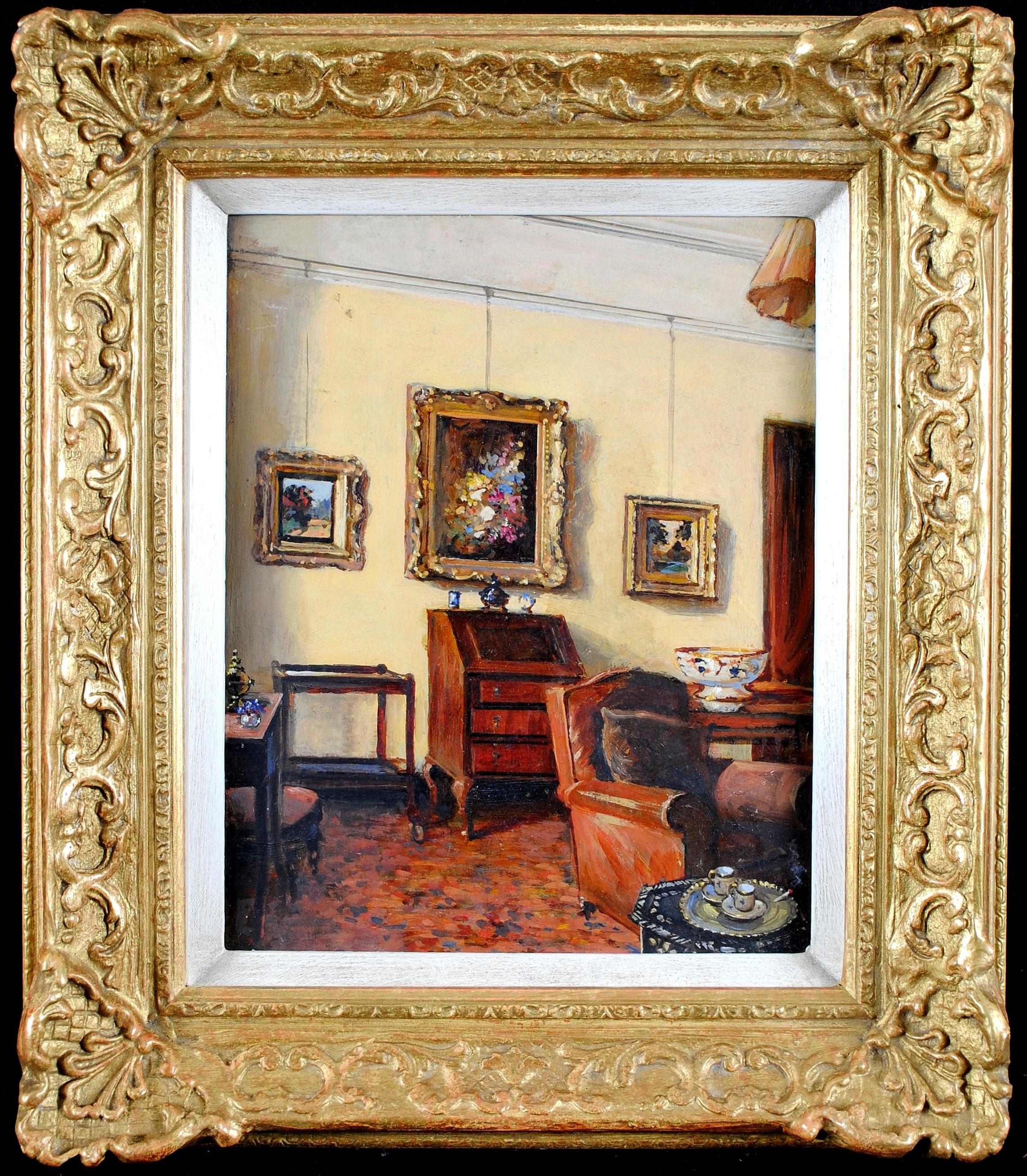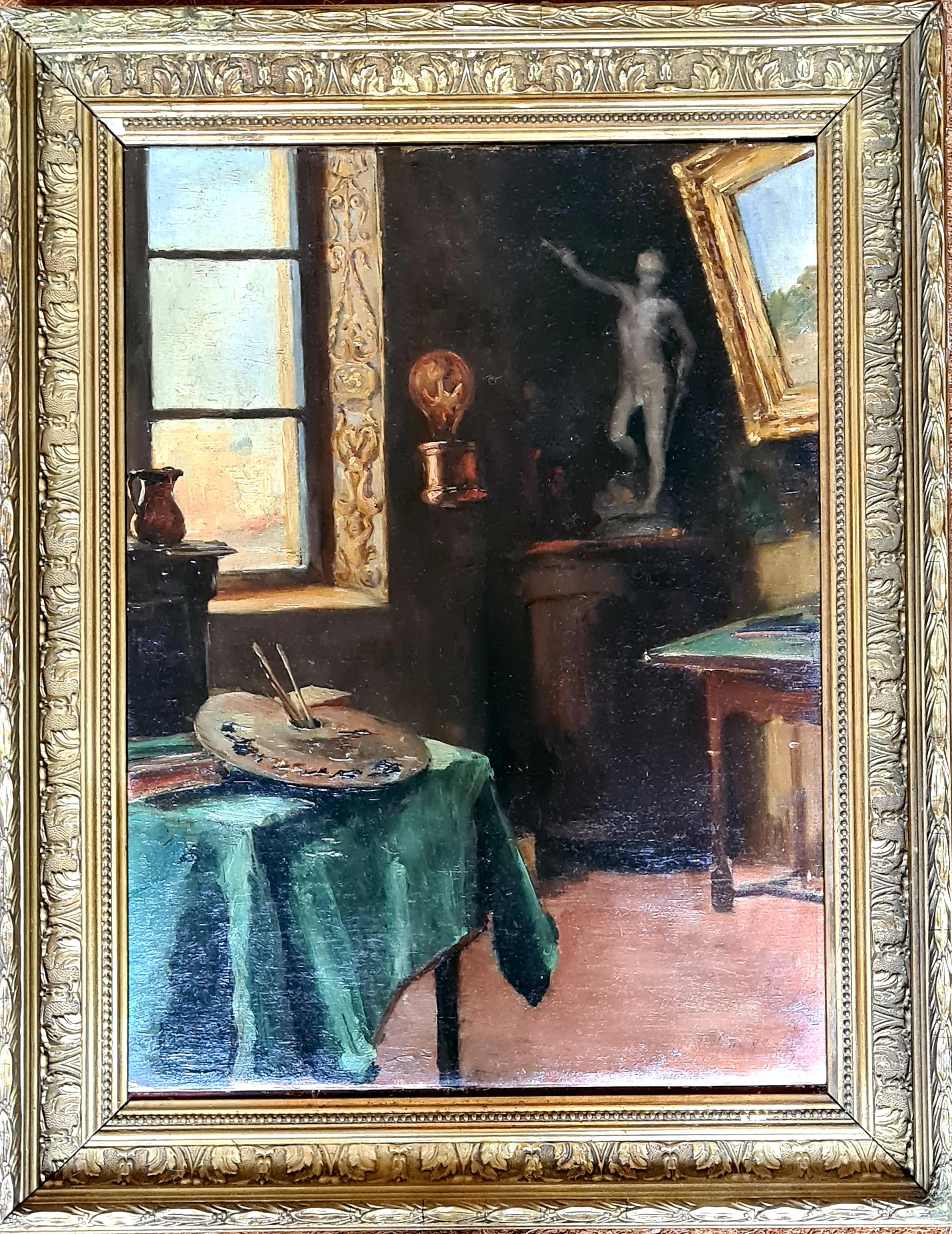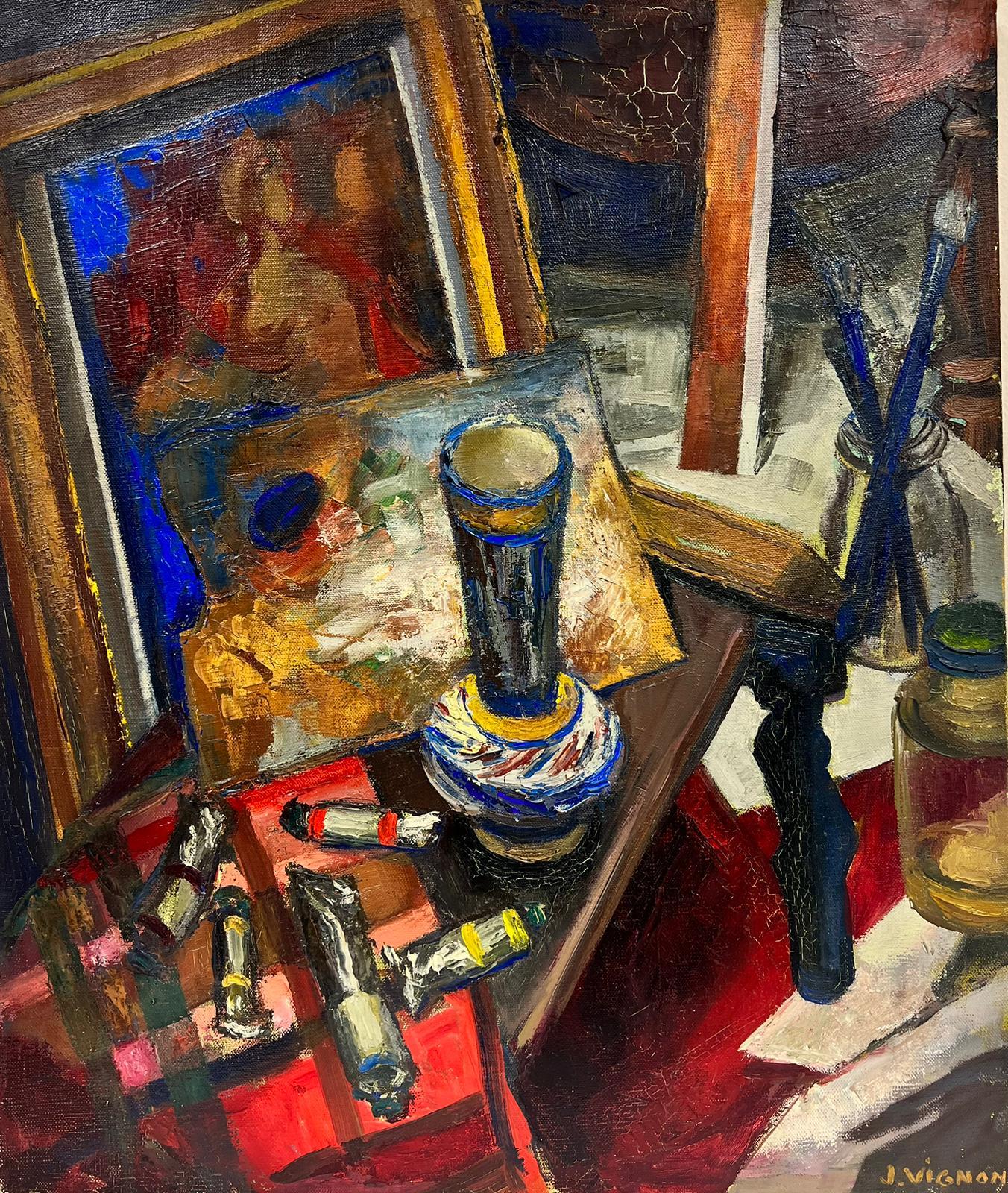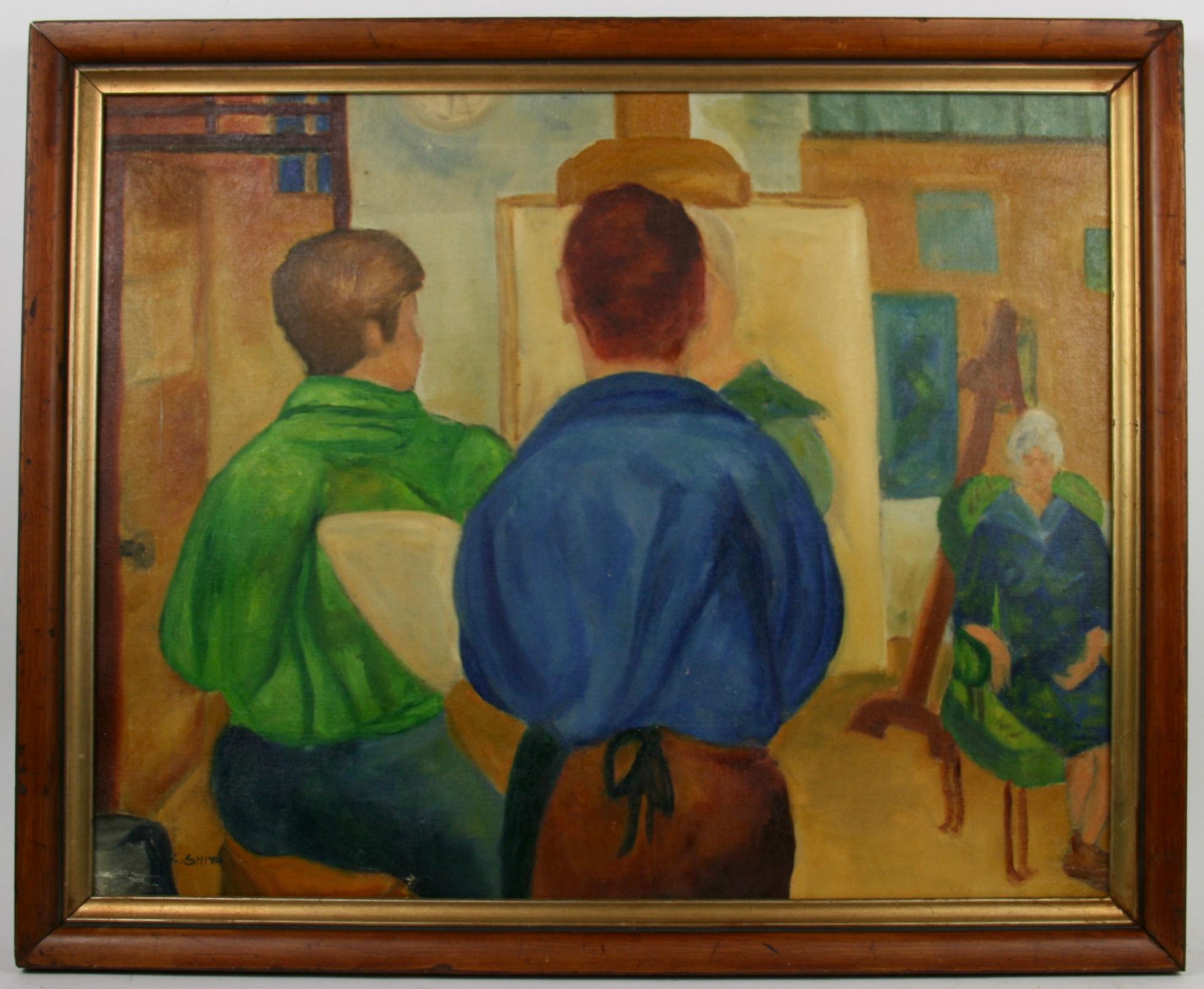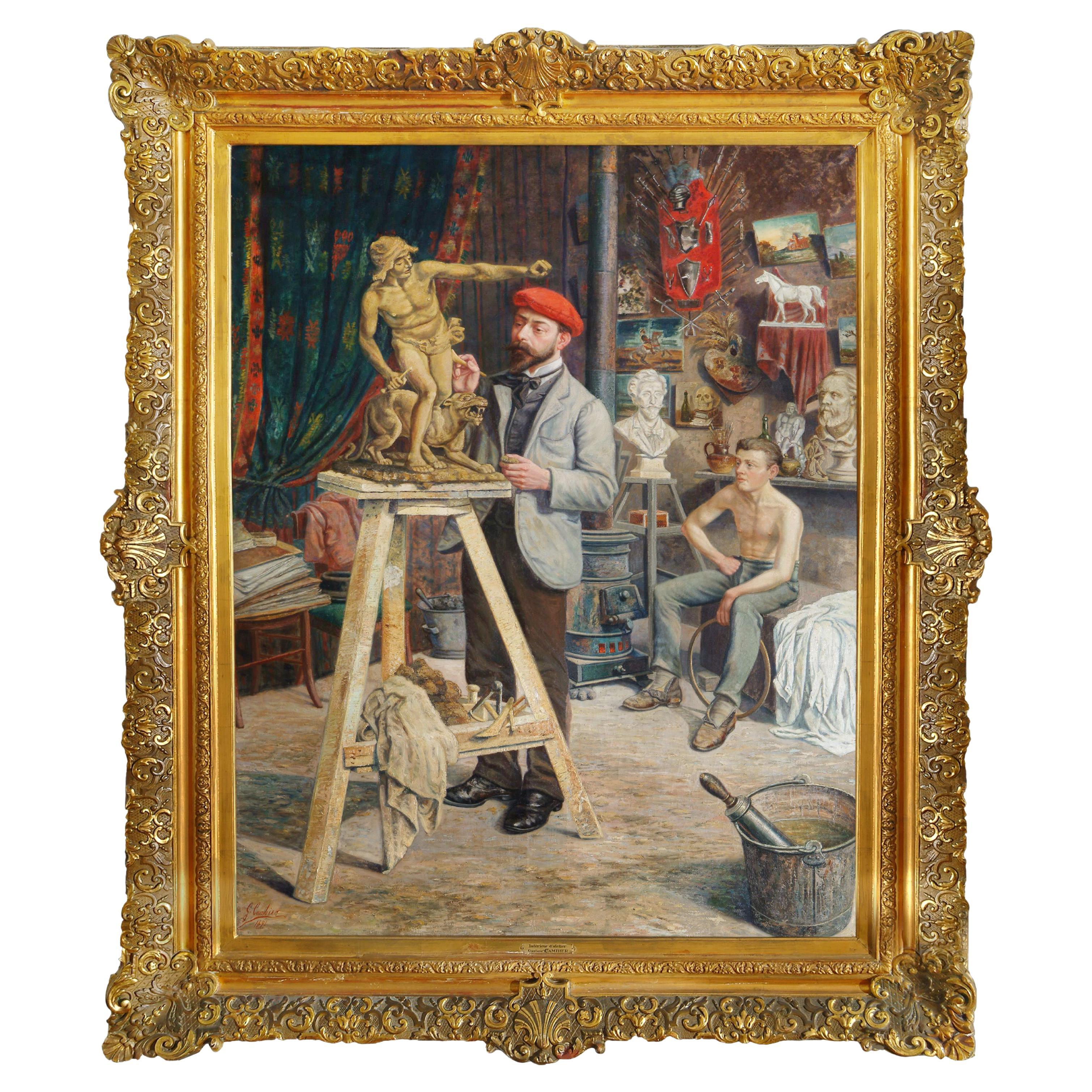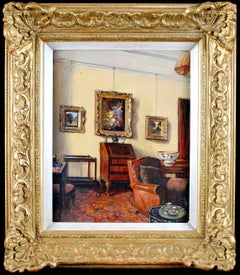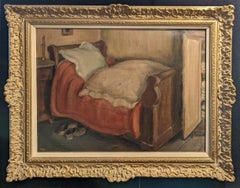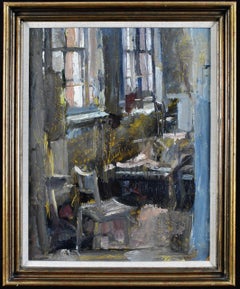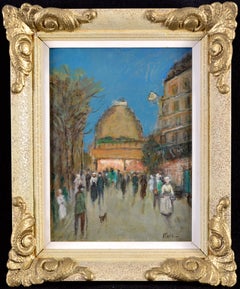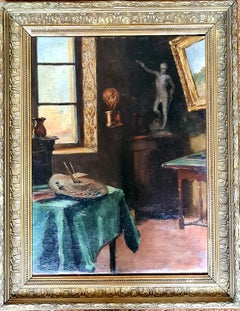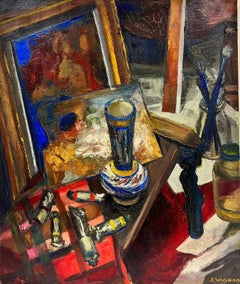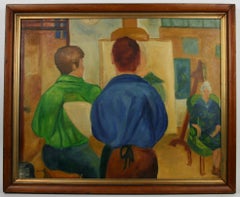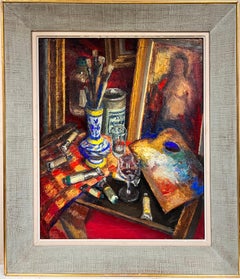Items Similar to L'atelier - Early 20th Century French Post Impressionist Interior Oil Painting
Want more images or videos?
Request additional images or videos from the seller
1 of 10
Early 20th Century French SchoolL'atelier - Early 20th Century French Post Impressionist Interior Oil Paintingc.1920
c.1920
$2,031.34
£1,500
€1,757.95
CA$2,801.30
A$3,147.13
CHF 1,644.38
MX$38,412.24
NOK 20,878.85
SEK 19,653.04
DKK 13,118.50
About the Item
* No US duty or taxes to pay on this item *
A beautiful 1920's French post-impressionist oil on canvas depicting an artist's atelier with painting on an easel, palette, brushes in the foreground and numerous paintings on the wall.
Excellent quality and very quirky French interior, presented in what is possibly the original Montparnasse carved wood frame.
Artist: French School, early 20th century
Title: L'atelier
Medium: Oil on canvas
Size: 19 x 22 inches (48 x 56 cm) including the frame
- Creator:Early 20th Century French School
- Creation Year:c.1920
- Dimensions:Height: 18.9 in (48 cm)Width: 22.05 in (56 cm)
- Medium:
- Movement & Style:
- Period:
- Condition:
- Gallery Location:Sevenoaks, GB
- Reference Number:1stDibs: LU1955216462612
undefined
About the Seller
5.0
Platinum Seller
Premium sellers with a 4.7+ rating and 24-hour response times
Established in 2016
1stDibs seller since 2022
124 sales on 1stDibs
Typical response time: 2 hours
- ShippingRetrieving quote...Shipping from: Sevenoaks, United Kingdom
- Return Policy
Authenticity Guarantee
In the unlikely event there’s an issue with an item’s authenticity, contact us within 1 year for a full refund. DetailsMoney-Back Guarantee
If your item is not as described, is damaged in transit, or does not arrive, contact us within 7 days for a full refund. Details24-Hour Cancellation
You have a 24-hour grace period in which to reconsider your purchase, with no questions asked.Vetted Professional Sellers
Our world-class sellers must adhere to strict standards for service and quality, maintaining the integrity of our listings.Price-Match Guarantee
If you find that a seller listed the same item for a lower price elsewhere, we’ll match it.Trusted Global Delivery
Our best-in-class carrier network provides specialized shipping options worldwide, including custom delivery.More From This Seller
View AllLiving Room Interior - Early 20th Century English Impressionist Oil Painting
Located in Sevenoaks, GB
A beautiful 1930's English impressionist oil on metal board depicting a living room interior with leather club chair, bureau, cigarettes in an ash tray and paintings on the wall.
Ex...
Category
Early 20th Century Impressionist Interior Paintings
Materials
Oil
Bedroom Interior - French Mid 20th Century Post Impressionist Oil Painting
Located in Sevenoaks, GB
Beautiful 1940's French post impressionist oil on board by Simon Simon-Auguste.
The work depicts a simple bedroom interior with shoes, candle and a single picture on the wall. Signed lower left and presented in a swept impressionist style frame.
Provenance: Chilham Castle, Kent
Artist: Simon Simon-Auguste (French, 1909-1987)
Title: Bedroom Interior
Medium: Oil on board
Size: 25.5 x 30.5 inches (65 x 77 cm) including frame
Simon Joseph Simon-Auguste (20 April 1909 – May 1987) was a French artist, known for his intimate paintings, mainly portraits, nudes and still lifes. His production is characterized by a calm, intimate feel, and the effective use of glaze.
Born in Marseille, Simon-Auguste was the son of Antonin Auguste, a cabinetmaker specialized in restoring furniture in the chateaux of the Provence.
Simon studied at the École communale of his neighborhood at rue Eydoux, in Marseille, where he excelled in design.
In 1931 Simon-Auguste finished his studies at the École des Beaux-Arts and won the Stanislas-Torrents award. He was commissioned to execute the mural decorations of the town hall in Allauch. He began exhibiting in Marseille where doctors and lawyers purchased his paintings.
In 1932 he invested into a 6-month stay in Paris where he frequented the Louvre Museum and became specially interested in the Camondo Collection. At the invitation of art dealer Adolphe Basler, he took part in the Moins de trente ans exhibition, at the Galerie de Sèvres, along with Jacques Despierre, André Hambourg, Louis Dideron, Léon Couturier, among others. He presented a nude, a still life, and a view of the Jardin du Luxembourg. He also started dealing with Georges Petit and the Galerie Vildrac.
In 1933 Simon-Auguste had his first solo exhibition at the Galerie Detailles, at the Canebière in Marseille which contributed to his success. He displayed 40 pieces (paintings, watercolours and sketches), mostly nudes and genre scenes.
In 1934 he married a philosophy student who would become a journalist under the pseudonym of Michele Seurière. For his second solo exhibition at the Galerie Detailles a few landscapes and marines were added to his portfolio.
During the 1930s Simon-Auguste explored subjects around nudes and landscapes. Later these evolved into children, still lifes and locals, full of intimacy and simplicity, which gained him a lot of recognition. Among these, we find La fillette au bol and Tête d'Enfant, which were purchased by the Musée Longchamp, Marseille.
It was 1939 when he could afford to move to Paris. The family settled at 38 rue de Malte and Simon-Auguste started submitting his work to the Salon d'Automne, Salon des Peintres Témoins de Leur Temps, and other major exhibitions.
At the outbreak of World War II, he was on holiday in Auvergne. In 1940, he was mobilized. Within two months he had to retreat to Ussel, forced by his ill health. In 1941 he reconverted a rented farm there into his atelier.
Simon-Auguste returned to Paris after the Liberation in 1944, to take part for the first time in the Nationale with La Fillette aux Pommes.
Up to 1947 Simon-Auguste signed his paintings with fountain pen ink. Afterwards, he used brush oil.
He spent some Summer holidays in Villiers-sur-Morin in the late 1940s. In 1949 he traveled around Italy: Rome, Florence, Siena, San-Giminiano, Venice, Milan.
In 1950 he was appointed member at the Salon d’Automne. This year he submitted Le Café du Commerce to the Grand Prix de la Peinture Contemporaine, at the Marsan Pavilion (Louvre Museum). He was amongst the 100 painters selected by the jury.
Also in 1950 the city of Paris acquired his Marine de La Rochelle. The Musée du Château de Sceaux acquired Paysage de l'Ille-de-France. The French state acquired La Fillette à la lampe in 1952, Nature morte aux Bleuets in 1953, and Comme un Poisson dans l’Eau in 1955.
In 1951 he contributed to an itinerant exhibition around Switzerland (Bern, Lausanne and Geneva) about Les fleurs et les fruits...
Category
1940s Post-Impressionist Interior Paintings
Materials
Oil
The Studio - Fine Mid 20th Century Interior Oil on Board Painting Agnew's London
By Lord Paul Ayshford Methuen
Located in Sevenoaks, GB
A beautiful c.1950 oil on board by Lord Paul Ayshford Methuen RA depicting the artist's studio with light pouring in through two large sash windows.
The ...
Category
Mid-20th Century Interior Paintings
Materials
Oil, Board
$2,925 Sale Price
20% Off
Free Shipping
Parisian Evening - Mid 20th Century French Post Impressionist Paris Painting
Located in Sevenoaks, GB
A beautiful mid 20th century French post-impressionist oil on panel depicting a busy summer evening in Paris.
Lovely quality atmospheric work which is indistinctly signed lower rig...
Category
Mid-20th Century Post-Impressionist Landscape Paintings
Materials
Oil, Panel
The Picture Gallery - Mid 20th Century French Naïf Figurative Oil Painting
By Fernand Boilauges
Located in Sevenoaks, GB
* No US duty or taxes to pay on this item *
A beautiful mid 20th century French naïf oil on panel depicting a family outside their art shop, by Fernand Boilauges.
The shop is named...
Category
Mid-20th Century Figurative Paintings
Materials
Oil
Café de la Gare - Mid 20th Century French Expressionist Figurative Oil Painting
Located in Sevenoaks, GB
A superb mid 20th century French expressionist oil on canvas depicting a café de la gare (station café) as inscribed on the reverse.
Numerous well dressed figures stand at the café ...
Category
Mid-20th Century Expressionist Landscape Paintings
Materials
Canvas, Oil
You May Also Like
Interior View, The Artist's Atelier, Late 19th Century, Oil on Canvas
Located in Cotignac, FR
Interior scene, late 19th century oil on canvas attributed to Paul-Jospeh Blanc. The painting is indistinctly signed and dated bottom right. The canvas is on a good chassis with keys...
Category
Late 19th Century Victorian Interior Paintings
Materials
Canvas, Oil
The Artist's Studio Post Impressionist Signed Oil Interior Scene
By Josine Vignon
Located in Cirencester, Gloucestershire
The Artists Studio
by Josine Vignon (French 1922-2022)
signed on front and back
oil painting on canvas, unframed
canvas: 22 x 18 inches
Colors: Red colors, brown, blue, white and o...
Category
Mid-20th Century Post-Impressionist Interior Paintings
Materials
Canvas, Oil
Vintage French Impressionist Artist Studio Interior Scene Figurative Painting
Located in Douglas Manor, NY
#5-3049 French Artist Studio,a 1970's figurative painting , oil on canvas displayed in a wood frame, signed by C.smith lower left.Image size 18.5 H x 23.25 W
Category
1970s Figurative Paintings
Materials
Oil
Beautiful 1960's French Post Impressionist Oil The Artists Studio Interior
By Josine Vignon
Located in Cirencester, Gloucestershire
The Artists Atelier
by Josine Vignon (French 1922-2022)
signed
oil painting on canvas, framed
framed: 37 x 32 inches
canvas: 29 x 24 inches
Colors: Green colors, beige, blue and gr...
Category
Mid-20th Century Post-Impressionist Interior Paintings
Materials
Canvas, Oil
Large Oil Painting "Intérieur D'atelier" ‘Workshop Interior’ by Gustave Cambier
By Louis Gustave Cambier
Located in Los Angeles, CA
Louis Gustave Cambier (1874-1949)
Titled: "Intérieur D'atelier" (Workshop interior).
This magnificent large oil painting on canvas depicts an elegantly dressed artist in his work...
Category
Antique 19th Century Belgian Paintings
Materials
Canvas
Scottish Interior - Edwardian art oil painting sitting room interior gilt frame
Located in London, GB
This stunning oil painting was painted circa 1911 and is signed lower right. The painting depicts a Scottish interior- a small occasion or card table surrounded by a variety of mahog...
Category
1910s Impressionist Interior Paintings
Materials
Oil
$5,416 Sale Price
20% Off
More Ways To Browse
Early 20th Century Wood Frame
Carved Posts
1920s Impressionist Painting
1920s French Oil Painting
Antique Artists Paint Brushes
Antique French Easel
Antiques Oil Interior Paintings
Antique Wood Easel
David Best
Miro Lithographs
Famous Etchings
Kennedy Photo
African American Portrait
Black Human Sculpture
1920s Vintage Prints
Picasso Plate Print
Unframed Antique Prints
Vintage Contact Paper
